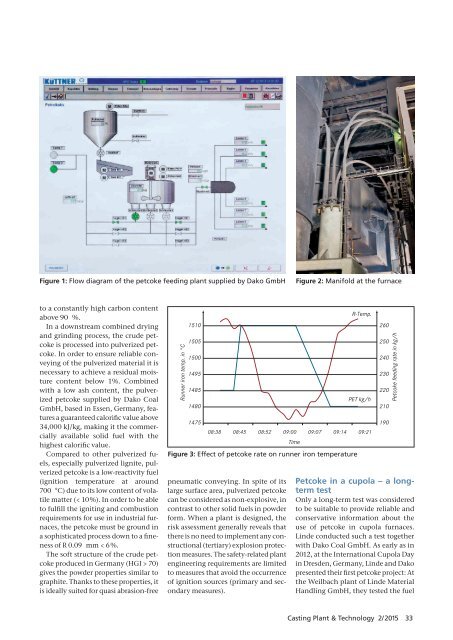CPT International 02/2015
The leading technical journal for the global foundry industry – Das führende Fachmagazin für die weltweite Gießerei-Industrie
The leading technical journal for the
global foundry industry – Das führende Fachmagazin für die
weltweite Gießerei-Industrie
Create successful ePaper yourself
Turn your PDF publications into a flip-book with our unique Google optimized e-Paper software.
Figure 1: Flow diagram of the petcoke feeding plant supplied by Dako GmbH<br />
Figure 2: Manifold at the furnace<br />
to a constantly high carbon content<br />
above 90 %.<br />
In a downstream combined drying<br />
and grinding process, the crude petcoke<br />
is processed into pulverized petcoke.<br />
In order to ensure reliable conveying<br />
of the pulverized material it is<br />
necessary to achieve a residual moisture<br />
content below 1%. Combined<br />
with a low ash content, the pulverized<br />
petcoke supplied by Dako Coal<br />
GmbH, based in Essen, Germany, features<br />
a guaranteed calorific value above<br />
34,000 kJ/kg, making it the commercially<br />
available solid fuel with the<br />
highest calorific value.<br />
Compared to other pulverized fuels,<br />
especially pulverized lignite, pulverized<br />
petcoke is a low-reactivity fuel<br />
(ignition temperature at around<br />
700 °C) due to its low content of volatile<br />
matter (< 10 %). In order to be able<br />
to fulfill the igniting and combustion<br />
requirements for use in industrial furnaces,<br />
the petcoke must be ground in<br />
a sophisticated process down to a fineness<br />
of R 0.09 mm < 6 %.<br />
The soft structure of the crude petcoke<br />
produced in Germany (HGI > 70)<br />
gives the powder properties similar to<br />
graphite. Thanks to these properties, it<br />
is ideally suited for quasi abrasion-free<br />
Runner iron temp. in °C<br />
1510<br />
1505<br />
1500<br />
1495<br />
1485<br />
1480<br />
pneumatic conveying. In spite of its<br />
large surface area, pulverized petcoke<br />
can be considered as non-explosive, in<br />
contrast to other solid fuels in powder<br />
form. When a plant is designed, the<br />
risk assessment generally reveals that<br />
there is no need to implement any constructional<br />
(tertiary) explosion protection<br />
measures. The safety-related plant<br />
engineering requirements are limited<br />
to measures that avoid the occurrence<br />
of ignition sources (primary and secondary<br />
measures).<br />
R-Temp.<br />
PET kg/h<br />
1475<br />
08:38 08:45 08:52 09:00 09:07 09:14 09:21<br />
Time<br />
Figure 3: Effect of petcoke rate on runner iron temperature<br />
260<br />
250<br />
240<br />
230<br />
220<br />
210<br />
190<br />
Petcoke feeding rate in kg/h<br />
Petcoke in a cupola – a longterm<br />
test<br />
Only a long-term test was considered<br />
to be suitable to provide reliable and<br />
conservative information about the<br />
use of petcoke in cupola furnaces.<br />
Linde conducted such a test together<br />
with Dako Coal GmbH. As early as in<br />
2012, at the <strong>International</strong> Cupola Day<br />
in Dresden, Germany, Linde and Dako<br />
presented their first petcoke project: At<br />
the Weilbach plant of Linde Material<br />
Handling GmbH, they tested the fuel<br />
Casting Plant & Technology 2/<strong>2015</strong> 33


















